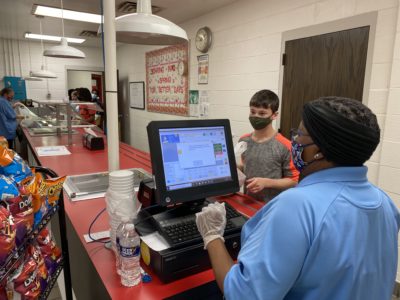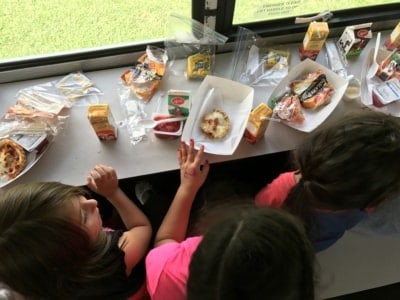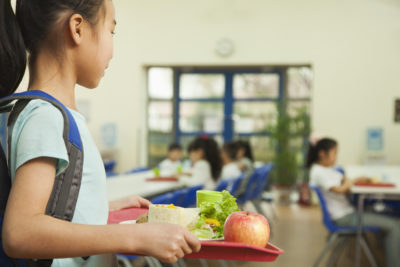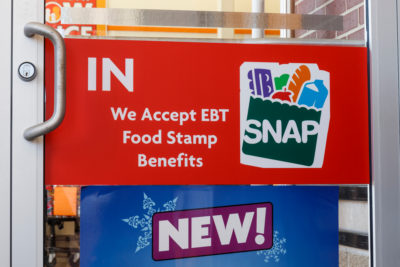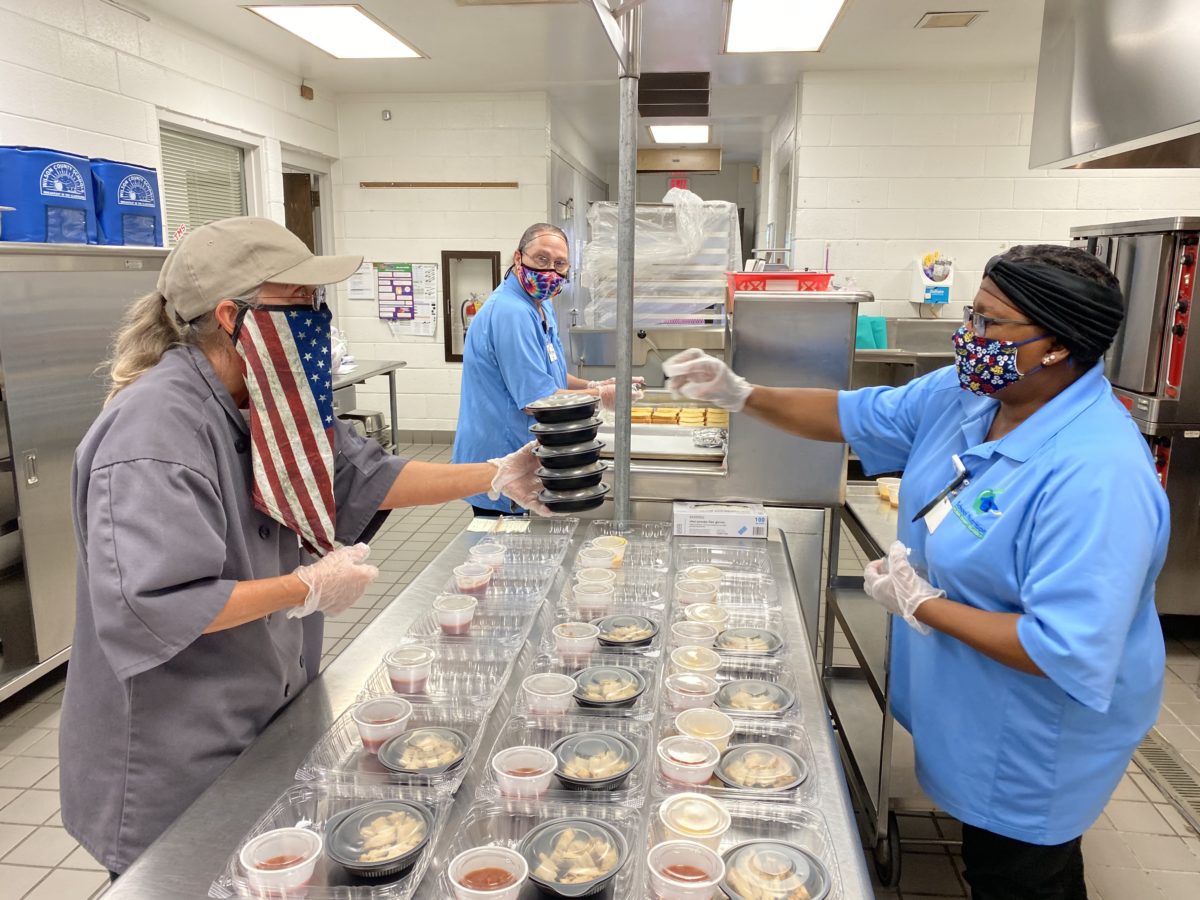
Share this story
- From declining participation amid the pandemic to supply chain disruptions, child nutrition departments nationwide are under financial strain. "It’s just going to be a rollercoaster the next couple years," said @NewHanoverCo's child nutrition director.
- “The best way to really think about it is we’re a restaurant within the school district." // Ever wondered how exactly school meals are funded? Take a closer look in our EdExplainer.
|
|
This article is part of a series looking at the future of school meals from policy to practice. We began with an EdExplainer on key child nutrition programs. This article provides an EdExplainer on how school food is funded and the financial challenges facing child nutrition departments.
“The best way to really think about it is we’re a restaurant within the school district,” said Amy Stanley, child nutrition director in New Hanover County Schools. Continuing with that analogy, Stanley’s department operates 46 “restaurants” — one in each of the district’s schools — and is solely responsible for the planning, budgeting, purchases, and labor that ensure meals are offered to the district’s 24,000 “customers,” or students. Each of those “restaurants” has to serve meals that meet strict nutritional standards using a federal reimbursement of less than $4 per meal to cover everything from food costs to equipment upgrades to staff salaries.
Child nutrition departments, also called school food authorities, operate financially independently of their school districts as self-sustaining, not-for-profit enterprises. This means that the money allocated to school districts from the federal, state, or local government is separate from the funding used for school food. As the lasting impacts of the COVID-19 pandemic continue to strain school nutrition departments nationwide, let’s take a closer look at how school food is funded and the financial challenges facing child nutrition departments.
Revenues
Child nutrition departments have two primary sources of revenue — federal reimbursements and student payments — with some matching funds provided by states.
Federal reimbursements
School meals are primarily funded through federal reimbursements from the U.S. Department of Agriculture. Child nutrition departments receive a per-meal reimbursement for each qualifying meal served, which means the meal must meet certain meal pattern guidelines and nutrition standards. The amount of that reimbursement depends on the eligibility of the student as either free, reduced-price, or paid.
Based on income level and a variety of other certifying factors, some students qualify for free or reduced-price meals, while other students pay for full-price meals. The reimbursement rates also depend on which child nutrition program the meal is being served as part of. For example, there are different reimbursement rates for the Summer Food Service Program compared to the National School Lunch Program. For more on eligibility and the key child nutrition programs, read our school meals primer.
Changes to school meals amid the pandemic
Since March 2020, a USDA waiver has allowed schools to serve school breakfast and lunch to all students free of charge and receive higher reimbursement rates for those meals using the flexibilities provided by the Seamless Summer Option (SSO). During the 2021-22 school year, roughly 90% of school districts nationwide are using these flexibilities and providing free meals to all students regardless of their income.
But without action from Congress to authorize the USDA to continue extending waivers, these flexibilities will expire on June 30, 2022, marking the end of a more than two-year period where school meals were provided at no cost to students across the country. Learn more about school meals for all here.
In the 2021-22 school year, under the National School Lunch Program, schools in the contiguous 48 states receive a maximum reimbursement of $3.90 per free lunch, $3.59 per reduced-price lunch, and $0.50 per full-price lunch. Under the School Breakfast Program, meal reimbursements depend on if the school is determined to be in “severe need” — indicating they serve a higher percentage of needy children — or in “non-severe need.” Schools in the contiguous 48 states facing severe needs receive a $2.35 reimbursement per free breakfast served, while schools facing non-severe needs receive a $1.97 reimbursement per free breakfast served.
In addition to per-meal reimbursements, child nutrition departments also receive commodity funding from the USDA Foods in Schools Program. Allotted based on participation in the National School Lunch Program, these funds can be used to purchase commodity foods from the USDA such as beef, chicken, turkey, cheese, and apples. In 2019, the program provided roughly $0.36 per lunch, amounting to $1.2 million in funding that purchased 1.3 million pounds of commodity foods.
Student payments
The second primary form of revenue comes from student payments for meals and à la carte items. Students who are eligible for reduced-price meals pay a small copayment per meal, and students who are not eligible for free or reduced-price meals pay the full price per meal. The exact prices for reduced-price and paid school meals are set by local school districts, usually with school board oversight.
School nutrition departments also receive payments when students purchase à la carte items. This includes snacks from a concession stand or snack shop that are not part of federally reimbursable school meals.
State support
Every state participating in federally-funded school nutrition programs is required to provide a certain amount of matching funds based on a set rate. However, state funding for school nutrition programs varies widely, ranging from per-meal reimbursements to salary support to general funding for operations. While some states like Indiana provide no additional state funding for meal reimbursements, states like California and Maine have appropriated funding to offer free school meals to all students by paying the difference between the federal reimbursements and the cost of school meals for all.
In North Carolina, a law passed in 2011 allocates a portion of the required state revenue match to cover the $0.30 copay for all students who receive reduced-price breakfasts, allowing all students who qualify for free or reduced-price breakfast to eat breakfast for free.
Costs
Child nutrition departments purchase every input used to serve school meals — from the chemicals to clean equipment to the ice machine to the lunch trays.
There are three primary types of costs that child nutrition departments incur to produce school meals. Roughly 80% of Stanley’s budget in New Hanover County is salaries, food, and food supplies, while the other 20% is equipment and overhead.
- Food and food supplies: This includes all the food components that are part of a reimbursable school meal, as well as the materials used to serve the food, from lunch trays to servingware.
- Labor: The child nutrition department pays for the salaries of staff who prepare meals and oversee operations. Right now, Stanley’s department employs about 200 employees, most of whom are part-time.
- Equipment and overhead: This includes the equipment used to produce school meals and other overhead expenses, such as the lights in the cafeteria.
School districts also have the ability to charge child nutrition programs overhead or indirect costs for operating within the school district. For example, these charges can cover the child nutrition department’s share of lights and facility maintenance.
Financial challenges
Although school nutrition departments have always operated on tight budgets, the pandemic has caused additional financial strain for many programs. The confluence of lower participation in school meals amid the pandemic coupled with supply chain disruptions, rising food costs, and staffing shortages means that many child nutrition departments are facing shortfalls.
Declining participation
When the COVID-19 pandemic closed school buildings, participation in school meals dropped drastically nationwide, and they are still recovering. A recent report from the Food Research and Action Center found that average daily participation in the National School Lunch Program declined 30% from the 2018-19 to 2020-21 school years, dropping from 28.5 million children to 19.8 million children. Fewer meals served means fewer reimbursements.
Compounding this is the fact that the USDA waiver that currently allow schools to serve free meals to all students is set to expire at the end of June. If the waivers aren’t extended, schools that aren’t covered by the Community Eligibility Provision will switch back to the usual pre-pandemic system — collecting applications for free and reduced-price meals, verifying student eligibility, and collecting meal payments, all of which could cause participation to decrease even further.
“It’s just going to be a rollercoaster the next couple years,” said Stanley. In New Hanover County, participation rates continue to be lower than pre-pandemic levels.
Supply chain disruptions and rising food costs
According to Stanley, disruptions in the supply chain and increased food costs have caused her department to reduce the number of daily lunch offerings from four to two. She can’t purchase the products needed to produce the kinds of school meals she used to.
A March survey from the USDA found that 92% of school food authorities reported experiencing challenges due to supply chain disruptions such as limited product availability and orders arriving with missing or substituted items. When asked what the impact of these supply chain disruptions were, the most commonly cited answer was increased staff stress and workload, followed by increased program costs.
Compounding these supply chain disruptions are the rising costs of food. During a presentation in February, Lynn Harvey, director of school nutrition and district operations for the North Carolina Department of Public Instruction, said that the costs of food and food preparation supplies had increased an average of 20-25% in the school nutrition marketplace over the last two years.
To provide relief to school nutrition departments facing supply chain disruptions, the USDA announced $1.5 billion in funding in December 2021, including funding to schools to purchase food, funding for states to purchase food to distribute to schools, and funding for cooperative agreements to purchase local food for schools. Across all three allocations, North Carolina received a total of $42 million in supply chain assistance.
Staffing shortages
Harvey also said that child nutrition departments in North Carolina faced a 13-27% average in staff vacancies at the start of the 2021 school year. The USDA’s March survey found that labor shortages were widespread nationwide, with 73% of school food authorities reporting staffing challenges. The most commonly cited staff shortages were cooks and food preparation staff, drivers, and maintenance workers.
Looking ahead
As the fate of the USDA waivers allowing schools to serve free meals to all students hangs in the balance, Stanley is focused on her budget for next year. She expressed a need for increased state funding as well as a desire to have the federal government continue providing an option for universal free school meals.
“I had hoped that with them seeing that we can do this with the pandemic … I was really hoping they would say let’s just cut the application, let’s just cut this burden, and let’s just do all kids at no cost,” said Stanley.


